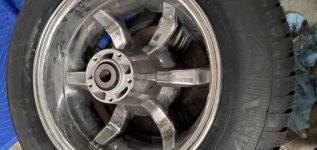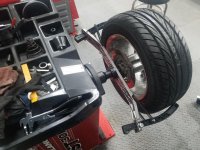Woodaddict
Well-known member
pinkRosePetal location is UK, they have much more salt in air from ocean, its an BIG island like living near coast in USA
What makes you think it's my bike?
Regarding the corrosion photos you're likely correct. That bike was brought to me for a tyre change at approx 8000 miles. After dismantling the rear wheel we found what you see in the pictures and the seal was completely wiped out, a rusty bearing and there was corrosion also on the sprocket and it was replaced under warranty. It was then, when refitting the new parts, we discovered just how tight the spacers fit into the new seals and it explained how the seals were wiped out and how that allowed the ingress of water to the bearing which you can see is fairly rusted. We machined the spacers and completed the job, the owner was made aware and that was that.I lived in Pennsylvania and my adjusters bearing and seal were fine on my 2012 RT when the tire was changed. The pictures shown looks like something that would happen if the bike was ridden in the winter with rock salt on the roads.
Sorry for my ignorance.... but who is Bob and where can I watch this video?
Thank you,
P.W.

UPDATE:
I did the wheel removal and tire install today. Following every ones advice, the job it's self was pretty straight forward. Took longer to get the tire mounted on the rim than doing the work.
What did I learn:
Removing the sensor in the swing arm was the worst part.
I tried to remove the belt with out taking the shock bolt out. I was not able to do it that way, once I removed the bolt from the shock there was no problem.
Bearings and seals looked good.
The manual shows removing the hub, my wheel has a solid hub nothing to remove ( I guess that is what you call it) the brake disc mounts right to it I removed the brake disc on one side and the drive pulley on the other.
Mr. Tire had no problem mounting but said he never seen a rim like that and could not balance it, did not charge for the mounting.
I reinstalled wheel and torqued to specs too it for an extended test ride, would never no it was not balance super smooth.
Tire is a 205 60 15 Quad Trac 5
Thank you all that chimed in and gave e your input and advice.View attachment 174424

Even though I did not get it balanced, you would never know it is actually better than some balanced tires on my Audi Q7. I decided to remove the brake rotor did not want to take a chance of the tire shop messing it up, only 5 bolts to remove. I could not find a bike shop that would balance it with a car tire mounted. Anyway all is good and I do appreciate everyone that offer tips, tricks, and advice.
My tire shop put some commercial quality liquid balance (NOT Slime or Ride-On!) in my tire since they couldn't spin balance it. It's the same stuff they use in truck tires. Works good.Even though I did not get it balanced, you would never know it is actually better than some balanced tires on my Audi Q7. I decided to remove the brake rotor did not want to take a chance of the tire shop messing it up, only 5 bolts to remove. I could not find a bike shop that would balance it with a car tire mounted. Anyway all is good and I do appreciate everyone that offer tips, tricks, and advice.
You have all the tools you need...... Except two. First is patience. Go slow. The second is bandaids. To successfully complete any job requiring tools you must bleed at least once..... Jim
I just changed my rear tire last week, 3rd tire on the bike but first time using a car tire on the back. I changed out my bearings and seals bc I had read here that they were failing at low mileage, but then I found out that it was old info and not true. My bearings were fine as well as the seals and no corrosion anywhere and I live in a beach town on the east coast and ride in the rain a lot. I'm not sure what kind of conditions these bikes in question are riding in, maybe they brine the roads in the UK and these folks are riding on a wet salty road. But even so the one bike only had 350 miles on it. I do remember one time I drove my Goldwing to Florida in the winter and I95 was salted in a few areas. When I got home 2 weeks later I found the rear wheel was heavily corroded. Ever since then I wash my bike a couple times during my trips.
